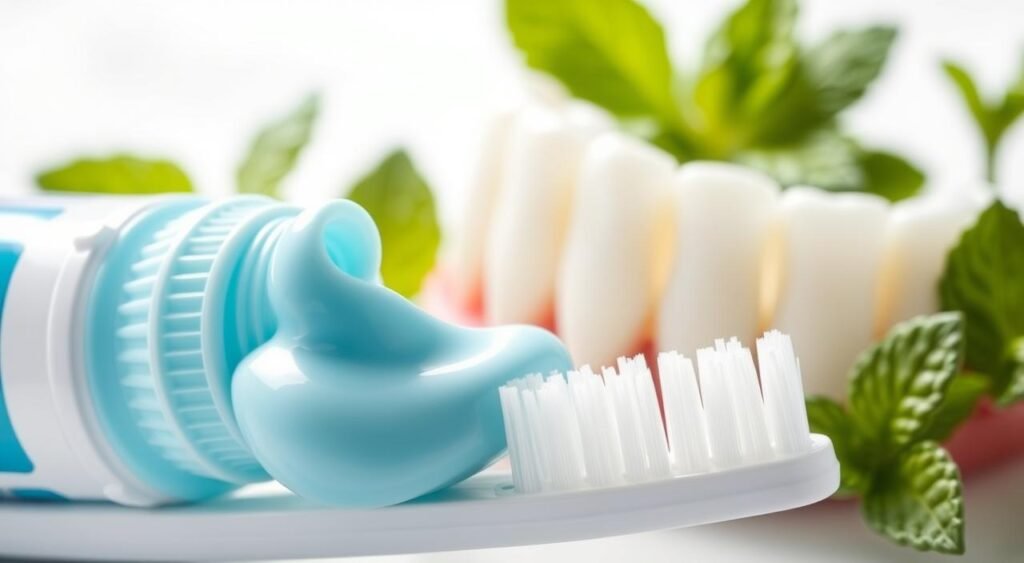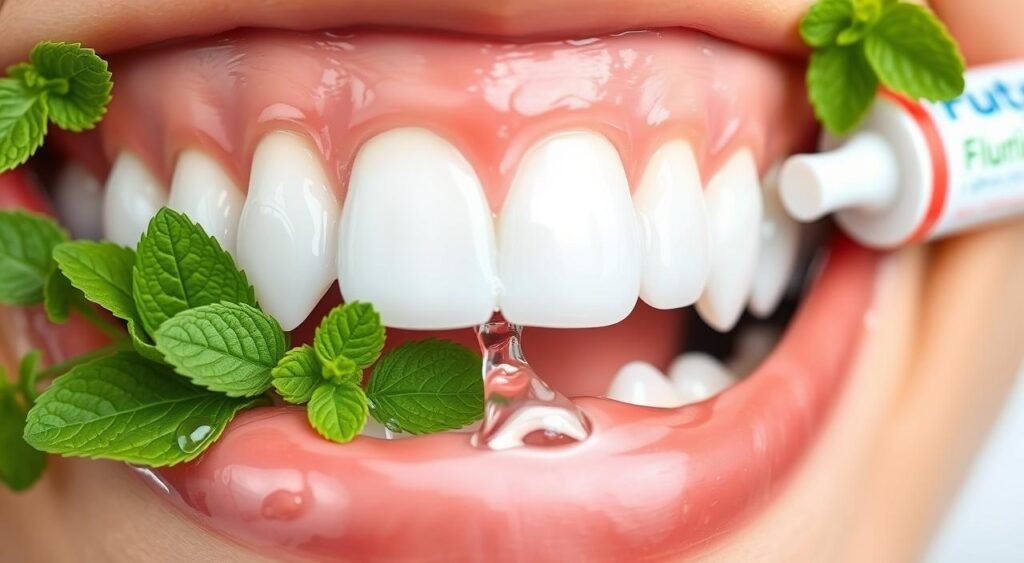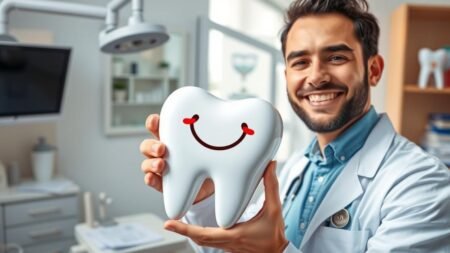Ever thought if fluoride in toothpaste or water can whiten teeth? The link between fluoride and teeth whitening raises a big question. Does fluoride whiten teeth? We’ll explore how fluoride affects both your teeth’s health and appearance, and whether it plays a role in making your smile brighter.
Fluoride is a key mineral for healthy teeth and stopping cavities. But, its role in whitening teeth is not clear. We’ll dive into what fluoride is, its role in oral health, and how too much fluoride might affect tooth color.
Introduction to Fluoride and Teeth Whitening
Fluoride is a mineral found in rocks, soil, and water. It’s key for keeping teeth healthy. But, its link to teeth whitening is not simple.
Definition of Fluoride
Fluoride is a compound with the fluoride ion (F-). It’s in toothpaste, mouthwashes, and treatments. It helps teeth and gums stay healthy.
Fluoride’s Role in Oral Health
Fluoride makes tooth enamel stronger. It stops harmful bacteria and prevents plaque and gum disease. So, fluoride is vital for healthy teeth.
But, fluoride doesn’t directly help with whitening teeth. We’ll look into this more in the next section.
Does Fluoride Whiten Teeth?
The Short Answer: No
Fluoride does not whiten teeth, despite what many think. It’s a key mineral for oral health but can’t lighten your smile. Too much fluoride can even cause dental fluorosis, leading to tooth stains.
Potential for Tooth Discoloration with Excessive Fluoride
Fluoride is found in water, soil, and food. It’s good for teeth when taken in the right amounts. But too much, especially before age 8, can cause dental fluorosis.
This condition can stain teeth white, yellow, or brown. So, if you want a whiter smile, look into other whitening options. Fluoride whitening toothpaste and fluoride whitening treatments have other benefits but not whitening.
Causes of Tooth Discoloration
Knowing why teeth get discolored is key to fixing it. Many things can make teeth look stained or discolored. Let’s look at the main reasons:
Foods and Beverages
Drinking dark liquids like coffee, tea, and cola can stain teeth. These drinks can get into the enamel, making teeth look bad.
Tobacco Use
Smoking or using tobacco products can really stain teeth. Nicotine and tar in tobacco make teeth look yellow or brown. Studies say tobacco causes up to 60% of tooth discoloration.
Age and Enamel Thinning
As we get older, our enamel wears down. This exposes the yellow or brown dentin underneath. This makes teeth look more discolored with age.
Medications
Some medicines, like tetracycline, can stain teeth in kids. Other drugs, like antidepressants, can also stain teeth.
Fluorosis
Too much fluoride can cause fluorosis. This can make teeth look white, yellow, or brown. It can also cause pitting or mottling.
Knowing what causes tooth discoloration helps us prevent or fix it. This way, we can keep our smiles bright and confident.
Fluoride-Free Alternatives for Teeth Whitening
Fluoride is good for our teeth but not for whitening. Luckily, there are fluoride-free ways to get a whiter smile. These options are safer than too much fluoride.

Whitening Toothpaste
Whitening toothpaste is a cheap and easy way to brighten your smile. It has special ingredients that remove stains. This makes your teeth look whiter and shinier. Top picks include Crest 3D White and Colgate Optic White.
Whitening Strips
Whitening strips are a simple, fluoride-free choice. They use peroxide to slowly make your teeth lighter. Brands like Crest 3D White and Opalescence are popular.
Whitening Gels
Whitening gels offer a more precise whitening. You apply them directly to your teeth. This gives a stronger whitening effect. Zoom and Opalescence are good choices.
Whitening Mouthwashes
Whitening mouthwashes are easy to use in your daily routine. They remove stains and brighten your teeth. Try Crest 3D White or Colgate Optic White.
These fluoride-free options help you get a brighter smile safely. You don’t have to worry about too much fluoride.
Home Remedies for Teeth Whitening
Many people choose home remedies for whitening teeth instead of professional treatments. Options like baking soda, hydrogen peroxide, activated charcoal, and coconut oil pulling are affordable and natural. They can make your smile brighter without costing a lot.
Baking Soda and Water Paste
Baking soda is a favorite for whitening teeth at home. Mix it with water to make a paste. Brush it on your teeth gently. Baking soda can remove stains and brighten your teeth.
A 2012 study showed baking soda and peroxide toothpaste can whiten teeth in 6 weeks.
Hydrogen Peroxide Rinse
Hydrogen peroxide is also good for whitening teeth. Mix it with water and use it as a rinse. But be careful not to swallow it.
Hydrogen peroxide can lighten teeth by breaking down stains. But use it carefully to avoid tooth sensitivity.
Activated Charcoal
Activated charcoal is popular for whitening teeth. It’s a porous substance that absorbs stains. A 2019 study found it can whiten teeth in 4 weeks.
But it’s not as effective as other whitening toothpastes.
Coconut Oil Pulling
Coconut oil pulling is a traditional method. Swish a tablespoon of coconut oil in your mouth for 20-30 minutes. It’s believed to remove plaque and stains.
But there’s no strong scientific proof it works well for whitening teeth. It can also have bad effects if done too much.
Professional Teeth Whitening Treatments
Looking for a deep clean? Professional teeth whitening by dentists can change your smile. These treatments use strong agents for quick results, often in one visit. Laser whitening can brighten teeth by several shades in 60 to 90 minutes.
Dentists also offer custom trays and strong whitening products for home use. These tailored solutions give you a steady whitening effect over weeks or months. Professional whitening costs $500 to $1,000, and home kits are $150 to $400.
Professional whitening gives amazing results, but they’re not forever. The whitening can last months to years, based on your health and habits. Some might feel tooth sensitivity or gum irritation during the process.
Dentists use special agents to make treatments safer and less painful. Potassium nitrate and fluoride help protect your teeth and ease sensitivity. With the right care, even sensitive teeth can get professional whitening safely.
Tips for Preventing Tooth Discoloration
Keeping your smile bright and healthy is more than just whitening. It’s about stopping stains before they start. Simple habits can fight off common tooth stains.
Limit Dark-Colored Beverages
Coffee, tea, red wine, and dark sodas stain teeth. They have chromogens that stick to enamel, causing discoloration. Drink less of these or use a straw to reduce tooth contact.
Quit Smoking and Tobacco Products
Smoking or chewing tobacco badly discolors teeth. Tar and nicotine turn teeth yellow or brown. Quitting is the best way to keep your smile white.
Rinse Mouth After Consuming Staining Foods/Drinks
Rinsing with water or chewing sugarless gum helps after staining foods. It removes pigments and acids that stain teeth.
Use a Straw for Staining Beverages
Drinking dark drinks through a straw reduces tooth contact. This simple trick helps keep teeth looking good.
Adding these tips to your daily life stops tooth stains. You’ll keep a bright, confident smile for years.
Conclusion
Fluoride is key for keeping teeth healthy and stopping cavities. But, it doesn’t make teeth whiter. The main job of fluoride is to make teeth stronger against damage.
If you want a brighter smile, there are fluoride-free ways to get it. You can use special toothpastes, strips, or even make a paste with baking soda. Hydrogen peroxide rinses also work well.
To keep your teeth looking good, there are things you can do. Try to drink less dark drinks, don’t smoke, and rinse your mouth after eating or drinking things that stain. These habits can help keep your teeth white and healthy for a long time.
Frequently Asked Questions
Does fluoride whiten teeth?
No, fluoride doesn’t whiten teeth. Too much fluoride can cause fluorosis, leading to white or brown stains.
Can fluoride cause tooth discoloration?
Yes, excess fluoride can cause fluorosis, resulting in white or brown stains on teeth.
What are the causes of tooth discoloration?
Discoloration can be caused by dark foods, drinks, tobacco, age, or excess fluoride.
What are some fluoride-free alternatives for teeth whitening?
Try whitening toothpaste, strips, gels, or mouthwashes without fluoride for whitening options.
What are some home remedies for teeth whitening?
Home remedies include baking soda paste, hydrogen peroxide, activated charcoal, and coconut oil pulling.
What professional teeth whitening treatments are available?
Dentists offer laser whitening, custom trays with gel, and prescription treatments for teeth whitening.
How can I prevent tooth discoloration?
Limit staining foods, quit smoking, rinse after meals, and use a straw for drinks to prevent discoloration.









3 Comments
thank you very much for this post
Pingback: Pregnancy Safe Teeth Whitening: Tips for Moms-to-Be
Pingback: Whitening Teeth Cost: Affordable Smile Makeover Options